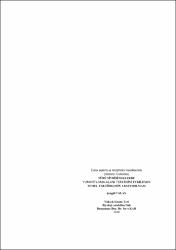| dc.contributor.author | Talay, Şengül | |
| dc.date.accessioned | 2020-02-10T11:28:26Z | |
| dc.date.available | 2020-02-10T11:28:26Z | |
| dc.date.issued | 2019 | |
| dc.identifier.uri | https://hdl.handle.net/20.500.11776/3586 | |
| dc.description.abstract | Sivrisineklerin yumurtalarını bıraktıkları, dolayısıyla larva ve pupa dönemlerini geçirdikleri su içeren üreme alanları, artropodun bütün yaşam evresi üzerinde etkili olan bir ortamdır. Bu ortamın özellikleri, sivrisineğin gelişim süresini, vücut büyüklüğünü, hayatta kalma yetisini, ortaya çıkan yetişkinlerin beslenme ve üreme performansını, vektörlük yeteneğini ve popülasyon yoğunluğunu doğrudan etkileyebilmektedir. İlgili nedenlerden dolayı, sivrisineklere ait üreme alanı özelliklerinin ve/veya sineğin yumurtlama noktasındaki eğilim veya tercihlerinin belirlenmesi, hem mücadelede hem de temel ekolojik çerçevenin belirlenmesinde önemlidir. Yapılan bu çalışmada, Culex pipiens ve Anopheles maculipennis türü sivrisineklerin üreme alanı tercihinde etkili olabilecek bazı parametreler araştırılmıştır. Bu noktada esasen, gebe dişilerin aynı alana yumurtlama eğilimi, tür içi ve türler arası düzlemde ele alınmıştır. Yarı doğal sera ortamında yapılan çalışmada, uygun boyutlarda tel kafeslere (100 x 200x100 cm) yerleştirilen, içerisinde yavru balık yemi ve 500 ml su (h: 4cm) bulunan CDC ovitraplar (h:15 cm; R: 11 cm) kullanılmıştır. Kafeslere doymuş dişi sivrisinekler konmuş olup, deneme süresince, kafesteki dişi sayısı en azından ovitrap sayısına denk olacak şekilde ayarlanmıştır. Denemelerde türler tek tek ve birlikte konmuşlardır. Yumurta sayıları, deneme süresince günlük olarak kaydedilmiş ve ilk pupaların görülmesiyle birlikte denemeler sonlandırılmıştır. Sonuç olarak; Cx. pipiens denemelerinde tek ovitraba en az 1 yumurta paketi, en fazla ise 12 yumurta paketi bırakılmıştır. An. maculipennis dişilerinin aynı alana yumurtlama denemesinde, dört ovitraba hiç yumurtlanmazken, tek ovitraba bırakılan en fazla yumurta sayısı 364 olmuştur. İki türün birlikte bulunduğu denemelerde ise, Cx. pipiens bütün kaplara yumurtlarken, An. maculipennis üç ovitrapta hiç yumurtlamamış, tek ovitraba ise en yüksek 495 yumurta bırakmıştır. Denemelerde, An. maculipennis yumurtalarından hiç biri ergin evresine ulaşamazken, Cx. pipiens ergin evreye başarıyla ulaşmıştır. Bu çalışma, aynı türe ait yumurta varlığının dişiyi alana yumurtlama konusunda aktive ettiğini ve bu noktada Cx. pipiens’in, An. maculipennis’e göre çok daha az seçici bir tür olduğunu göstermiştir. | en_US |
| dc.description.abstract | The oviposition site areas, where the mosquitoes oviposit their eggs and thus pass the larval and pupa periods, are an environment which affects the whole life stage of the arthropod. The characteristics of this environment may directly affect the developmental duration of the mosquito, body size, survival, feeding and reproductive performance of adults, vectorial capacity and population density. For relevant reasons, the identification of the reproductive site characteristics of mosquitoes and / or their tendency or preferences on oviposition site is important in determining both the control and the basic ecological framework. In this study, some parameters which may be effective on the preferences of reproduction area of Culex pipiens and Anopheles maculipennis species were investigated. At this point, the tendency of gravid females to oviposit in the same area is discussed in the intra- and inter-species plane. In the study conducted in semi-natural greenhouse environment, CDC ovitraps (h: 15 cm; R: 11 cm) with fry fish feed and 500 ml water (h: 4 cm) were placed in appropriate sizes of wire cages (100 x 200x100 cm). Engorged female mosquitoes were placed in the cages, and during the trial, the number of females in the cage was adjusted to at least equal to the number of ovitraps. In the experiments, species were put together individually and together. The number of eggs was recorded daily during the trial and trials were terminated with the first pupa seen. As a result; in the Cx. pipiens trials, at least one egg package was left to the single ovitrap and 12 eggs were left as the highest level. In the trials related to An. maculipennis females, no eggs were seen in four traps, the maximum number of eggs left to the single ovitrap was 364. In the trials with two species together, it was inspected that Cx. pipiens oviposited in all ovitraps, however An. maculipennis did not lay eggs in three ovitraps, and 495 eggs were left in single ovitrap as the highest level. In trials, none of An. maculipennis eggs reached the adult stage, but Cx. pipiens successfully reached the adult stage. This study shows that the presence of eggs of the same species activates the female to oviposit in the area, and Cx. pipiens is much less selective than An. maculipennis | en_US |
| dc.language.iso | tur | en_US |
| dc.publisher | Namık Kemal Üniversitesi | en_US |
| dc.rights | info:eu-repo/semantics/embargoedAccess | en_US |
| dc.subject | Anopheles maculipennis | en_US |
| dc.subject | Culex pipiens | en_US |
| dc.subject | Yumurtlama alanı tercihi | en_US |
| dc.subject | Anopheles maculipennis | en_US |
| dc.subject | Culex pipiens | en_US |
| dc.subject | oviposition site preference | en_US |
| dc.title | Culex pipiens ve anopheles maculipennis (diptera : culicidae) türü sivrisineklerde yumurtlama alanı tercihini etkileyen temel faktörlerin araştırılması | en_US |
| dc.title.alternative | INVESTIGATION OF THE BASIC FACTORS AFFECTING THE OVIPOSITION SITE PREFERENCE OF Culex pipiens and Anopheles maculipennis (Diptera: Culicidae) MOSQUITO SPECIES | en_US |
| dc.type | masterThesis | en_US |
| dc.department | Enstitüler, Fen Bilimleri Enstitüsü, Biyoloji Ana Bilim Dalı | en_US |
| dc.relation.publicationcategory | Tez | en_US |



















